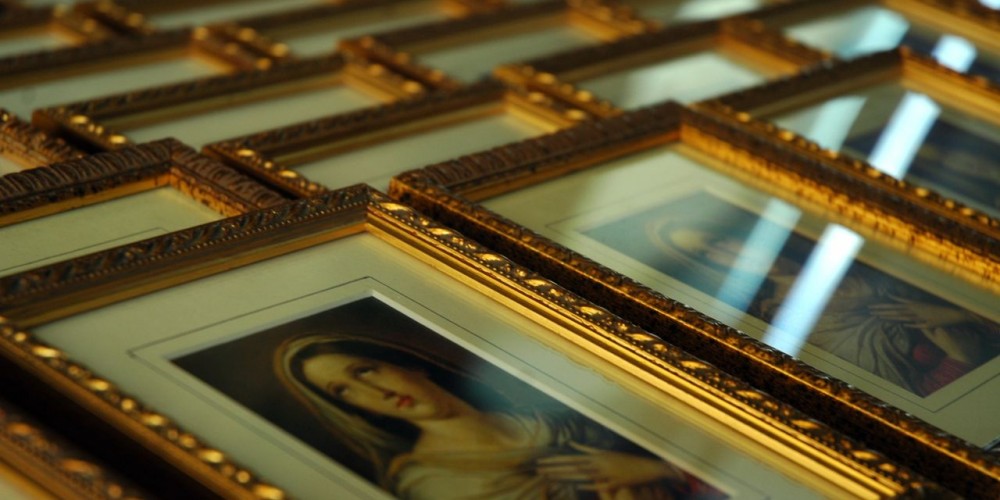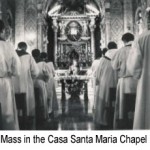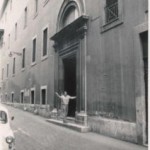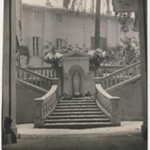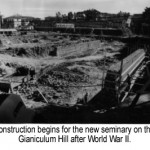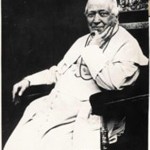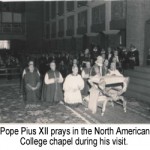History of the College
Three books are available for a more in-depth look at the history of the College:
The Pontifical North American College: Celebrating 150 Years …
The Second Founder: Bishop Martin J. O’Connor and the Pontifical North American College
Aggiornamento on the Hill of Janus: The American College in Rome, 1955-1979
In 1854 Cardinal Wiseman of Westminster proposed the idea of a pontifical college in Rome for training American diocesan clergy, which won the approval of Pope Pius IX. Also in 1854, the Holy Father sent Archbishop Gaetano Bedini as a papal legate to the United States. Bedini came back with two recommendations (1) that a formal nuncio be sent to the United States and (2) that an American college be founded in Rome. Persuaded by the pope’s concern and prodded by the enthusiasm of Bedini who was now Secretary of the Propagation of the Faith, the American bishops of a youthful country sent two priests to Rome in 1856 to study the situation, resulting in Pittsburgh’s Bishop O’Connor’s trip the following year to finalize arrangements. The Congregation of the Propaganda purchased the property in Rome on Humility Street on September 22, 1858. The house was first a Dominican convent, built in 1598 by Donna Francesca Orsini, who chose the name of “Our Lady of Humility” for it. The Napoleonic Wars, however, forced the sisters out of the house. In 1814 the Sisters of the Visitation, founded by St. Francis de Sales, obtained the property, only to be forced out in 1849 by the forces of the Roman Republic. The French troops who soon entered the city in opposition to the Roman Republic then used the building as a barracks.
The French soldiers left only seven months before the college opened with the arrival on December 7, 1859, of twelve American students who had been staying at the Urban College of Propaganda Fide; along with Edward McGlynn, of the Archdiocese of New York, an upperclassman within only four months of priestly ordination, who had been assigned temporary prefect of the new group; and Dr. Bernard Smith, OSB, the first Pro-rector, originally from Ireland, affiliated with the Propaganda for many years, and spending the rest of his life in Rome. This group walked over in a festive parade from the Urban College to the new North American College and moved in December 7, 1859, one day before the official opening day.
The official ceremonies, December 8, 1859, were a Mass, celebrated by Archbishop Gaetano Bedini, in honor of the Immaculate Conception; a special pranzone (festive mid-day meal); and a papal audience with Pius IX at his invitation. On January 29, 1860, the pope returned the visit, saying Mass at the college, and staying for breakfast. Two years later he approved formally the loan of the buildings by the Sacred Congregation of the Propaganda to the Bishops of the United States. Dr. Dom Bernard Smith, OSB, pro-rector, served from December 1859 until the March 1860 arrival of the first American rector, William George McCloskey, who served until 1868.
The early years of the College were lean ones in terms of money and numbers of students. Both the United States Civil War and the Italian Republican movement culminating in the war for Italian unification had their effects including financial depression in the U.S. and inflation in Italy. The family of Rev. Louis Hostelot, rector from 1878-1884, was instrumental in assisting with the financing of the college’s mausoleum and chapel at Campo Verano, a cemetery in Rome. On October 25, 1884, Pope Leo XIII decreed the College’s institution as a pontifical college, thus turning its administration over to an Episcopal Committee; but the Propaganda Fide retained legal ownership until 1948, when Pope Pius XII gave it to the college corporation after World War II.
Rev. Thomas Kennedy, rector from 1901 to 1917, was a builder and developer, and by 1909 the College’s fiftieth anniversary, one hundred forty-seven students were enrolled. During his era he enlarged the College by adding the Pilotta wing to the Humility Street property, remodeling the baths, installing lighting, and saving funds for a new College. With the coming of World War I, Kennedy, consulting the U.S. State Department, kept the College open, but the enrollment dropped to twenty-five students by 1918. The enrollment rose again to one hundred eighty students by 1922. Rev. Charles O’Hern, rector from 1917-1925, installed central heating and a laundry. In 1924 the bishops of the United States gave authority to the Board of Trustees to contract a debt of $600,000 for the purchase of ten acres of Villa Gabrielli land on the Janiculum Hill, Rome, for the site of a new American College. The old college on Humility Street was to be used as a post-graduate house for American priests. The new property was paid for by 1929, and in 1933 improvements were made to the Casa San Giovanni, an eighteenth century building already on the Janiculum property, so that graduate students could be housed there before any large building projects were undertaken.
The coming of World War II delayed construction of a new building, for the seminary closed in May 1940, all the students leaving on a boat out of Genoa on June 2, 1940. The College’s Humility Street property was in the midst of the battle for Rome and housed war refugee orphans. The Janiculum property also housed many refugees along with their horses and sheep while the original villa housed American priests in the service of the Vatican. The construction of the present seminary, built for three hundred occupants, was undertaken from 1946 to 1953 under the rectorship of Bishop Martin J. O’Connor with Cardinal Francis J. Spellman as a member of the Episcopal Board. October 17, 1948, Bishop O’Connor broke ground on the Janiculum for the new college for which Count Enrico Galeazzi was the architect. In March 1949, students moved back into the refurbished house on Humility Street from the Alban hills outside of Rome where they had been living in the college’s Villa Santa Caterina since its post-war reopening in 1947. Pope Pius XII dedicated the completed new college on October 14, 1953. One hundred eighty-nine students moved into the new building, freeing the Casa Santa Maria for graduate student housing. To learn more about the tremendous role of Bishop Martin J. O’Connor in the history of the college, please click here.
October 11, 1959, the North American College celebrated its centennial. Moreover, Pope John XXIII visited the College in the afternoon of that day. The Second Vatican Council brought many students into the center of its activities, some acting as stenographers. Council theologians and scholars; e.g., Yves Congar, Hans Kung, Edward Schillebeeckx, and Raymond Brown, also visited the campus to give lectures, and the college hosted the Americans attending the Council. During those days and after, the college has welcomed priests, bishops, and cardinals who come to Rome for visits, consultations, consistories, synods, etc. In 1966 the Immaculate Conception Chapel was renovated according to the new liturgical requirements, and on February 22, 1970, Pope Paul VI visited the college.
Since 1933, students had no longer attended the Propaganda Fide College, switching at that time to the Gregorian University. Today’s students have many more options, attending the Gregorian, the Angelicum, Santa Croce, the Alphonsianum, San Anselmo, the Biblicum, and other universities of Rome. The Episcopal Committee and Board of Governors were reorganized, based on the regional divisions of the NCCB, which action helped to extend the regional bases from which to draw students. Furthermore, the Institute for Continuing Education of Priests was begun, and an Office for Development, first based in Rome, now in Washington, D.C., was established. Saint John Paul II, on February 22, 1980, paid a visit to the college, as had his immediate predecessors. The American bishops and gifts from benefactors provide the basic support for the college. Despite the changes in the world, in Rome, in the times, and in the college itself, its prime purpose and central task is and has been to form men for the Catholic priesthood for whatever time, place, or milieu in which they are called upon to serve.
